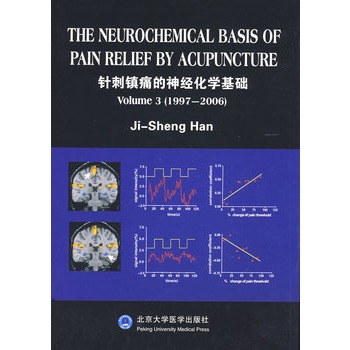|
|
|
 |
| 《针刺镇痛的神经化学基础 Volume 3(1997-2006)》 |
| 作者:韩济生 编著 |
| 出版社:北京大学医学出版社 |
出版日期:2008/1/1 |
| ISBN:9787811163490 |
定价: 128.00元 |
|
目录
1 OVERVIEW
1.1 Acupuncture activates endogenous systems of analgesia
1.2 Acupuncture anesthesia (AA) versus acupuncture-assisted anesthesia (AAA)
1.3 Electroacupuncture: mechanisms and clinical application
1.4 Acupuncture research & neuroscience development
1.5 Traditional and evidence-based acupuncture: history, mechanisms, and present status
1.6 Opioid and antiopioid peptides: a model of Yin-Yang balance in acupuncture mechanisms of pain modulation
1.7 Acupuncture: neuropeptide release produced by electrical stimulation of different frequencies
1.8 Heritability of nociception. HI. Genetic relationships among commonly used assays of nociception and hypersensitivity
1.9 The effect of genotype on sensitivity to electroacupuncture analgesia
2 PEPTIDE AND NON-PEPTIDE OPIOID AGONIST
2.1 Discrimination between peptide and non-peptide opioid agonists on the transcription of opioid receptors in two cell lines
2.2 Inhibition of the transcription of u opioid receptor by long-term exposure of SHSY5Y cell line to peptide and non-peptide opioid agonists
2.3 The metabolic evidence of synergistic effect between ohmefentanyl and [D-Pen2, D-PenS]enkephalin on differentiated SH-SY5Y cells in humans
2.4 The metabolic evidence of synergistic interaction between DAMGO and DPDPE on undifferentiated SH-SY5Y cells
3 ACUTE PAIN
3.1 Endomorphin-1 mediates 2 Hz but not 100 Hz electroacupuncture analgesia in the rat
3.2 Endomorphin and u-opioid receptors in mouse brain mediate the analgesic effect induced by 2 Hz but not 100 Hz electroacupuncture stimulation
3.3 Acupuncture and endorphins
3.4 Effects of synchronous or asynchronous electroacupuncture stimulation with low versus high frequency on spinal opioid release and tail flick nociception
3.5 Decreased dynorphin A ( 1-17 ) in the spinal cord of spastic rats after the compressive injury
3.6 Involvement of ionotropic glutamate receptors in low frequency electroacupuncture analgesia in rats
3.7 Characteristics of electroacupuncture-induced analgesia in mice: variation with strain, requency, intensity and opioid involvement ..
3.8 Relations between brain network activation and analgesic effect induced by low vs. high frequency electrical acupoint stimulation in different subjects: a functional magnetic resonance imaging study
3.9 Modulation of cold pain in human brain by electric acupoint stimulation: evidence from MRI
3.10 Evidence from brain imaging with fMRI supporting functional specificity of acupoints in humans
3.11 Modulation of pain signal processing by electric acupoint stimulation: an electroencephalogram study
3.12 Parallel pain processing in freely moving rats revealed by distributed neuron recording
3.13 Nociceptive responses of anterior cingulate cortical ensembles in behaving rats
3.14 Differential modulation of nociceptive neural responses in medial and lateral pain pathways by peripheral electrical stimulation: a multichannel recording study the analysis of cerebral evoked potentials
3.15 Sliding-window technique for
3.16 Coding of peripheral electrical stimulation frequency in thalamocortical pathways
3.17 A controlled study to evaluate the analgesic effect of transcutaneous electric nerve stimulation on post-operative pain in patients of cardiac operation: patient-controlled analgesia as the evaluation criterion
4 CHRONIC PAIN
4.1 Decreased GDNF mRNA expression in dorsal spinal cord of unilateral arthritic rat
4.2 Glial cell line-derived neurotrophic factor contributes to delayed inflammatory hyperalgesia in adjuvant rat pain model
4.3 Change of vanilloid receptor 1 expression in dorsal root ganglion and spinal dorsal horn during inflammatory nociception induced by complete Freund' s adjuvant in rats
4.4 Attenuation of mechanical but not thermal hyperalgesia by electroacupuncture with the of opioids in rat model of chronic inflammatory pain involvement
4.5 Repeated 100 Hz TENS for the treatment of chronic inflammatory hyperalgesia and suppression of spinal release of substance P in monoarthritic rats
4.6 Repeated administration of low dose ketamine for the treatment of monoarthritic pain in the rat
4.7 Ketamine potentiates the effect of electroacupuncture on mechanical allodynia in a rat model of neuropathic pain
4.8 Suppression of neuropathic pain by peripheral electrical stimulation in rats: &-opioid receptor and NMDA receptor implicated
4.9 Hyperpolarization-activated, cyclic nucleotide-gated cation channels: roles in the differential electrophysiological properties of rat primary afferent neurons
4.10 Ectopic discharges from injured nerve fibers are highly correlated with tactile aUodynia only in early, but not late, stage in rats with spinal nerve ligation
4.11 Inhibition ofhyperpolarization-activated current by ZD7288 suppresses ectopic discharge of injured dorsal root ganglion neurons in a rat model of neuropathic pain
4.12 Dynamic neuronal responses in cortical and thalamic areas during different phases of formalin test in rats……
5 ANTI-OPIOID PEPTIDES AND OPIOID TOLERANCE
6 DRUG DEPENDENCE
7 PARKINSION'S DISEASE
8 OBESITY
APPENDIX 1 Source of Paper
APPENDIX 2 Acupuncture research is part of my life
|
|
|